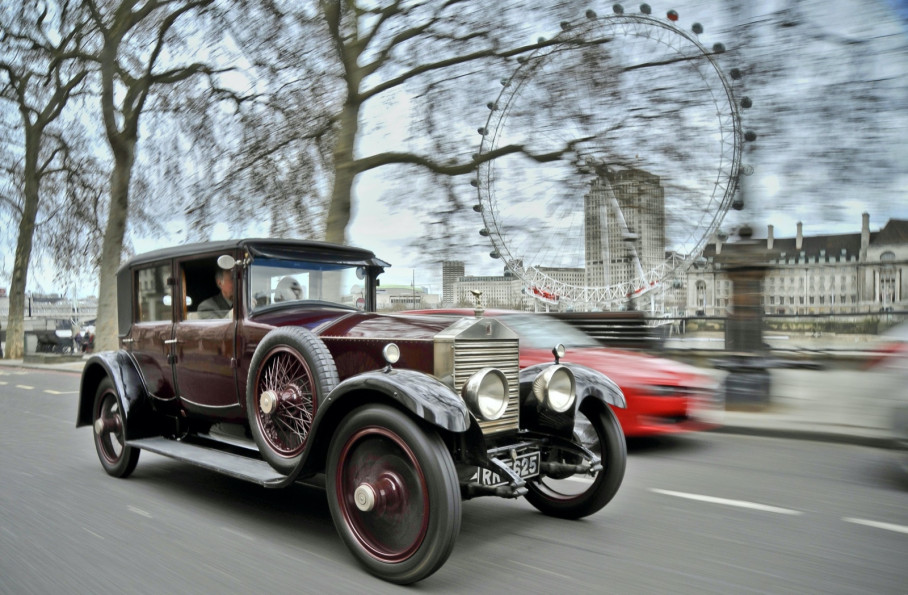

MODELS OF THE MARQUE: THE 1920s – ROLLS-ROYCE 20 H.P. THE ‘TWENTY’
“The legendary 20 H.P., known simply as the ‘Twenty’, was launched on 6 October 1922. Designed by Henry Royce, it ranks among the most important and transformational models ever produced by the marque. Its technology was highly advanced for the time and set the mechanical template for generations of Rolls-Royce motor cars that followed it. Smaller, lighter and less complex than its predecessors, it was also the first Rolls-Royce specifically intended for owners to drive themselves, rather than chauffeured use, reflecting the changed world in which Rolls-Royce found itself operating after 1918. More than a century later, its influence can still be seen in contemporary automotive engineering and design, including the models we build at Goodwood today – a remarkable motor car with an extraordinary legacy.” - Andrew Ball, Head of Corporate Relations and Heritage, Rolls-Royce Motor Cars
A CHANGED WORLD
Even before the Armistice was signed in 1918, Henry Royce was preparing for what he knew would be a very different post-war world. He reasoned that, given the likely difficulty of recruiting, retaining or affording a mechanic or chauffeur as they had done previously, some customers would no longer be able or willing to run the marque’s most popular pre-1914 model, the 40/50 H.P. ‘Silver Ghost’. He needed to create a motor car that was simpler to maintain – and, even more importantly, that the owner could more easily drive themselves. At the same time, Royce knew these discerning clients would expect and accept nothing less than the Rolls-Royce standards of excellence they were accustomed to – and neither would he.
THE ‘TWENTY’
On 6 October 1922, Rolls-Royce unveiled its new ‘small horsepower’ motor car, the 20 H.P., the first Rolls-Royce ever designed expressly to be owner-driven rather than chauffeured. It was immediately obvious that the ‘Twenty’, as it quickly became known, represented a huge technical leap forward. Its straight-six cylinder, 3.1-litre engine was less than half the size of the Silver Ghost’s 7.5-litre unit: however, the new model also weighed around 30% less. This meant the performance gap between them was far less than the raw numbers might suggest. Indeed, with its light controls and more advanced steering, braking and suspension systems, the ‘Twenty’ made the Silver Ghost seem rather outdated, although the larger model remained significantly ahead of its direct competitors.
The ‘Twenty’ quickly became a firm favourite both with established Rolls-Royce owners and those new customers for whom, as Royce had predicted, purchase price and ongoing running costs were more important considerations than they had been a few years earlier.
In letters to the motoring press, one happy owner praised it as ‘a charming piece of mechanism’ while another declared, ‘I have never handled anything as sweet-running’. A company advertisement quoted an expert assessment of the car as ‘everything a motorist can want… motoring with a high degree of refinement and its simplicity of construction will delight the driver’. After taking delivery of his car, a contented customer wrote to the company from his home in France declaring: ‘I drove my 20 H.P. here from Liverpool and am very satisfied with the running of the engine, not having to change gear between Liverpool and Versailles’.
WEIGHTY ISSUES
Like all Rolls-Royce models of the era, the ‘Twenty’ was produced as a ‘rolling chassis’, on which owners commissioned bespoke bodywork from an independent coachbuilder. Royce had always intended that it should primarily be an owner-driver car and hoped coachbuilders and customers alike would embrace this by keeping their creations as svelte and lightweight as possible.
However, he was unable to change the habits of a lifetime among some customers. Many owners persisted in specifying their preferred style of solid, formal coachwork that was both heavier and produced greater wind resistance. To Royce’s understandable irritation, these massive, overbuilt bodies inevitably compromised performance.
Ever the pragmatist, Royce knew there was only one way to improve the weight-to-performance ratio. In 1929, the ‘Twenty’ was replaced by the 20/25 H.P., powered by an enlarged capacity engine, followed in 1935 by the 25/30 H.P. with a 4.25-litre powerplant. The ‘small horsepower’ era finally came to an end with the Wraith of 1938. These later iterations, all direct developments of the ‘Twenty’, add further lustre to its record and reputation.
A LASTING INFLUENCE
The ‘Twenty’ had a profound influence on Rolls-Royce long after production ceased in 1929, by which time no fewer than 2,940 examples had been built. In particular, the straight six-cylinder engine – with detachable cylinder head and overhead valves – would provide the template for Rolls-Royce engines for years to come. Open the bonnet of any six-cylinder Rolls-Royce right up to the Silver Cloud model (1955-9) and their shared heritage is clear to see, albeit with many internal improvements. And when the by-then venerable Silver Ghost was replaced with the new Phantom in 1925, its engine also adopted the essential ‘Twenty’ pattern.